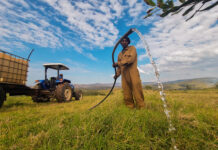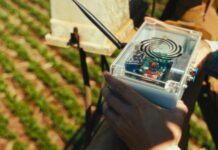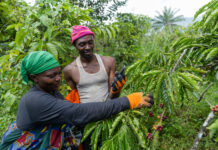By Fayelle Ouane, co-founder of Suguba, an Innovation Hub operating in several West African countries. Suguba’s vision is to foster a more integrated and empowered West Africa by giving a voice to the youth and escalating innovation in the region.
As we celebrate Africa Day and commemorate our varied accomplishments, let’s also take a few minutes to appreciate how agriculture has been instrumental in developing the continent, and how innovation is key to preserving it in future. We are “standing on the edge of a second green revolution” and smart ideas from our young Einsteins may just be what we need to fulfil Africa’s dream of becoming the world’s food basket and sustaining its economy.
Agriculture has been Africa’s bread and butter over the last century and it continues to do so. In addition to creating most of the jobs in Africa, over half the population depend on it for their livelihoods. According to Nepad, the agricultural population in Africa stands at 530 million people and is expected to exceed 580 million by 2020. Africa has 33 million farms of less than 2 hectares, accounting for 80% of all farms, and the agricultural labour force is comprised mostly of women. Although poor, Africa has the largest surface area of uncultivated arable land and is regarded as a major player in the global food market.
Nepad’s 2013 paper ‘Agriculture in Africa’ states that agriculture forms a significant portion of all African economies and contributes toward major continental priorities like eradicating poverty and hunger, boosting intra-Africa trade and investments, rapid industrialization and economic diversification, sustainable resource and environmental management, and creating jobs, human security and shared prosperity.
Former African Union chair, Dr Nkosazana Dlamini-Zuma said Africa would have a population of two billion people by 2050, the majority women and youth. She advised that Africans needed to create wealth and conserve its resources for future generations.
The agricultural sector has continued to absorb a large proportion of the working population and will continue doing so. By 2025, it is estimated that 330 million young Africans will have entered the labour market, with limited opportunities for finding jobs in cities. Agriculture in Africa has great potential for increasing growth and sustainable wealth creation.
Nepad’s chief executive Ibrahim Assane Mayaki in the paper said farmers were the primary guardians of Africa’s natural heritage and environmental assets, and they should be granted opportunities to preserve and build on those assets.
The report found that despite being self-sufficient in the 1960s, Africa had become a net importer of cereals. But since 2016, it’s core ingredient, maize, had been hit by a fall armyworm infestation. The outbreak in most parts of sub-Saharan Africa added further strain to food security, the impacts of which could be catastrophic for Africa, the poorest and most underdeveloped continent in the world.
The fall armyworm has a reputation for destroying maize but also feeds on more than 80 species of plants including rice, sorghum, millet, sugarcane, vegetable crops and cotton. In sub-Saharan Africa, over 200 million people depend on maize for food security as it is a staple cereal crop grown by farmers.
The pest has already caused more than $13 billion in crop losses. The Food and Agriculture Organization (FAO) of the United Nations revealed that by February 2018, only three out of 54 African States had not reported infestations.
The UK Aid stated in a report that the armyworm could potentially cause maize yield losses in a range of 8.3 million to 20.6 million tonnes per annum.
With the ongoing risks to food security posed by the fall armyworm, innovation could be crucial in finding solutions. Fresh approaches that help farmers identify, treat and track instances of the fall armyworm mean that farmers would have a better chance to protect their crops against the invasive fall armyworm.
Agriculture Research Council CEO Dr Shadrack Moephuli told delegates at the 3rd Global Food Security conference in Cape Town last year that innovations were crucial in assisting both commercial and smallholder farmers with food losses.
“These challenges reinforce the critical role of innovation to make agriculture more competitive and sustainable. Innovation is the new normal in agriculture,” he said.
Agriculture is currently standing on the edge of a second green revolution, according to PwC’s 2016 ‘Africa Agribusiness Insights Survey’. This revolution will entail fundamental shifts in how the agricultural sector utilises and implements innovative technology to improve output in a sustainable manner.
“Advances in technology and innovation are the key to the future of agriculture,” said Frans Weilbach, Agribusiness Industry Leader for PwC Africa in the insights report.
“Innovative technology and advancements in productivity are becoming increasingly important as pressure mounts…The global population is growing rapidly and the climate is ever-changing. Agribusinesses are making changes to go high-tech. From data-gathering drones to artificial intelligence farming, technology is making the agricultural sector more precise and efficient.”
PwC found that the agricultural sector to be one of the most critical industries for the African continent due to its economic potential, and is projected to become a US$1trillion industry in sub-Saharan Africa by 2030.
Taking a keen interest in the fall armyworm threat in Africa, Nesta, on behalf of Feed the Future, Land O’ Lakes International Development (LOL) and the Foundation for Food and Agriculture Research (FFAR) decided to roll up their sleeves and immediately search for innovative solutions. They held a competition between March and May targeting innovators from around the globe, in search of digital solutions and approaches that could provide timely, context-specific, actionable information to enable smallholder farmers and those who support them to identify, treat, and track incidence of the pest in Africa. The US Agency for International Development (USAID), together with LOL and FFAR contributed $400,000 in prize awards, and the winners will have a chance to develop their prototypes.
It will be interesting to see what kind of innovative ideas come out from this, and whether any of the prototypes can be developed successfully. After all, Africa — which has the largest surface area of uncultivated arable land — could also be home to the next Einstein. Let us preserve Africa by containing the fall armyworm threat and safeguarding our green revolution through innovative tools.








